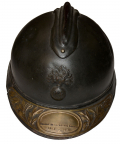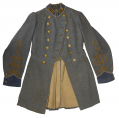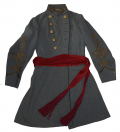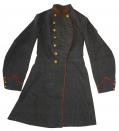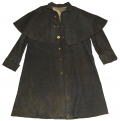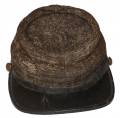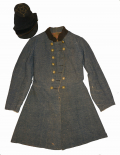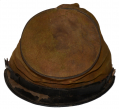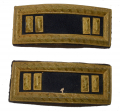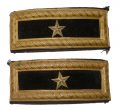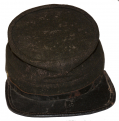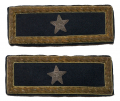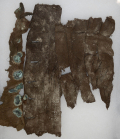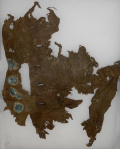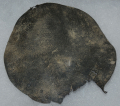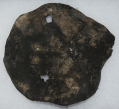site search
online catalog
Uniforms & Cloth
Showing 61 to 80 out of 216
WW1 FRENCH HELMET WITH VETERAN’S PLAQUE
A very clean example of the French M1915 Adrian helmet with very strong paint, comb and RF/bomb plate in place, as well as liner and chinstrap (detached on one end) and carrying an excellent example… (1202-705). Learn More »
WW1 ITALIAN HELMET, EX-JARRETT MUSEUM
A fine example of the Italian M1917 World War One helmet with original strong green paint and black painted Italian five-prong crown with the regimental number below. The comb is in place, as is the… (1202-696). Learn More »
$850.00
ON HOLD
CLOSE TO REGULATION VIRGINIA CONFEDERATE CAPTAIN'S FROCK COAT
The coat is made of mid- gray wool, possibly imported from England. It has full-length skirts ending in the typical and desirable raw edge. The sleeves have an 8 1/2-inch billow at the elbow. The dark… (1268-060). Learn More »
A SOUTH CAROLINA CONFEDERATE CAPTAIN'S SUPERB FROCK COAT
Worn by Robert Chisolm who formed Chisolm's Company, 1st Battalion South Carolina Sharpshooters on July 23,1862 after service in the artillery. This unit subsequently became Company A, 1st South… (1268-1006). Learn More »
A LOUISIANA CONFEDERATE ARTILLERY CAPTAIN'S FROCK COAT
This is an outstanding example that was until recently in the Fort Worth Texas Civil War Museum. The coat is double breasted and made of a dark gray wool satinet. There are seven Louisiana state… (1268-557). Learn More »
"HOMESPUN" CONFEDERATE SHELL JACKET - PVT WILLIAM B. MARSHALL, 2ND LOUISIANA CAVALRY
Private/trooper William B. Marshall trooper 2nd Louisiana cavalry wore this jacket until his death in a Union prison. Prior to it being in the Texas Civil War Museum it was the property of the author… (1268-367). Learn More »
A RARELY SEEN CONFEDERATE INFANTRYMAN'S GREATCOAT
Once in the famed museum collection of Ray Richey, this Confederate mid-gray infantry overcoat or greatcoat is all original and in very good condition all things considered. The hand sewn overcoat is… (1268-043). Learn More »
CONFEDERATE SURGEON'S KEPI FOUND IN SOUTH CAROLINA
This cap was discovered in a Civil War period home in Charleston SC near "The Battery" neighborhood not many years ago. When found the cap needed a few minor repairs but it otherwise remains untouched… (1130-09). Learn More »
A FINE EXAMPLE OF A CONFEDERATE INFANTRYMAN'S KEPI
This cap's crown, top and base band are made from a medium weight open weave woolen fabric which may be a blend of sorts. It certainly looks "home spun". The kepi gives indications of being a depot… (1268-037). Learn More »
A BEYOND RARE CS ARKANSAS FROCK COAT AND "BONNET DE POLICE"
Mr. Ray Richey, owner of the Texas Civil War Museum, purchased this uniform coat and hat directly from an Arkansas estate in 2003. Twenty-six years prior to this it was acquired from the Beneux… (1268-057). Learn More »
A FORAGE CAP THAT "WHISTLES DIXIE"
This coffee-colored wool forage cap was discovered in Morristown, Tennessee in 1964 by a Mr. Robert Walter. Based on the pre-war model 1858 cap it certainly is a wool and cotton blend and measures 3… (1268-554). Learn More »
NICELY MARKED SMITH PATENT CAPTAIN OF STAFF SHOULDER STRAPS
A very good condition and good looking set of Smith Patent shoulder straps for a Captain on staff duty. There were at least a couple of patents during the Civil War for some form of metallic border in… (490-7268). Learn More »
CIVIL WAR BRIGADIER GENERAL SMITH PATENT SHOULDER STRAPS
An excellent condition set of Smith Patent shoulder straps for a Brigadier General. James Smith’s patent used stamped and gilded brass metallic frames to imitate the bullion embroidered borders of… (490-7265). Learn More »
ZOUAVE FIRST SERGEANT CHEVRONS
These chevrons measure about 8 inches wide and 4 inches tall and use a red ground with three narrow, sewn, medium blue stripes and a diamond/lozenge, indicating a First Sergeant, the senior… (490-7153). Learn More »
CONFEDERATE DEEP SOUTH DEPOT ENLISTEDMAN'S KEPI
Federal soldier George Wilson, 21st Missouri Infantry (US), captured this cap at the Fort Blakely fight near Mobile, Alabama April 9th, 1865. The cap appears to have been mass produced at a clothing… (2025-300). Learn More »
$16,500.00
ON HOLD
BRIGADIER GENERAL’S SHOULDER STRAPS
A very nice condition pair of Civil War period Brigadier General’s shoulder straps showing signs of actually having been worn on a uniform. These measure 1-1/2” wide by 3-7/8” long and are… (2025-278). Learn More »
PIECE OF AN INDIAN WAR M1872 FATIGUE BLOUSE FROM FORT PEMBINA, ND
This is a portion of a rare Model 1872 fatigue blouse clearly showing the characteristic pleats of the pattern. These were replacements for the old Civil War M1858 fatigue blouse (the 4-button sack… (1052-579). Learn More »
PIECE OF AN INDIAN WAR M1872 FATIGUE BLOUSE FROM FORT PEMBINA, ND
This is a portion of the rare Model 1872 fatigue blouse. The pattern was a replacement for the old Civil War M1858 fatigue blouse (the 4-button sack coat,) made with the idea of giving the soldier… (1052-578). Learn More »
KEPI OR DRESS CAP STIFFENER FROM FORT PEMBINA
This comes from the excavations at Fort Pembina, ND, a small frontier army post in operation from 1870 to 1895, and is the stiffener from inside the top of a kepi a M1872 dress cap. It is black in… (1052-1152). Learn More »
KEPI OR DRESS CAP STIFFENER FROM FORT PEMBINA
This comes from the excavations at Fort Pembina, ND, a small frontier army post in operation from 1870 to 1895, and is the stiffener from inside the top of a kepi a M1872 dress cap. It is black in… (1052-475). Learn More »
Showing 61 to 80 out of 216
Most Popular
Historical Firearms Stolen From The National Civil War Museum In Harrisburg, Pa »
Theft From Gravesite Of Gen. John Reynolds »
Selection Of Unframed Prints By Don Troiani »
Fine Condition Brass Infantry Bugle Insignia »
featured item
REGULATION FROCK COAT, CAP, AND GREEN MEDICAL SASH OF ASST. SURGEON ELIAS WILDMAN 40th NEW JERSEY
This identified Union Army Assistant Surgeon’s group came out of the family and was in a respected Las Vegas uniform collection for about 25 years until its acquisition by the Texas Civil War Museum. The officer, Asst. Surg. Elias Wildman, served… (1268-751). Learn More »
site search
Upcoming Events
The shop is currently closed so that we may conduct our annual inventory. We are available by phone… Learn More »



